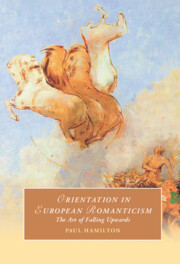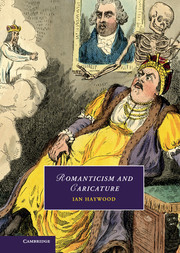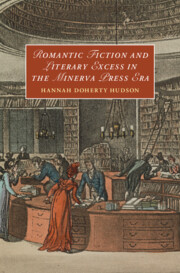Art, Science, and the Body in Early Romanticism
£22.99
Part of Cambridge Studies in Romanticism
- Author: Stephanie O'Rourke, University of St Andrews, Scotland
- Date Published: October 2023
- availability: Available
- format: Paperback
- isbn: 9781009001267
£
22.99
Paperback
Other available formats:
Hardback, eBook
Looking for an inspection copy?
This title is not currently available on inspection
-
Can we really trust the things our bodies tell us about the world? This work reveals how deeply intertwined cultural practices of art and science questioned the authority of the human body in the late eighteenth and early nineteenth centuries. Focusing on Henry Fuseli, Anne-Louis Girodet and Philippe de Loutherbourg, it argues that romantic artworks participated in a widespread crisis concerning the body as a source of reliable scientific knowledge. Rarely discussed sources and new archival material illuminate how artists drew upon contemporary sciences and inverted them, undermining their founding empiricist principles. The result is an alternative history of romantic visual culture that is deeply embroiled in controversies around electricity, mesmerism, physiognomy and other popular sciences. This volume reorients conventional accounts of romanticism and some of its most important artworks, while also putting forward a new model for the kinds of questions that we can ask about them.
Read more- Utilises rare archival material to reveal previously unknown connections between artistic practices and scientific ideas
- Includes innovative historical interpretations of major romantic artworks
- Demonstrates how the history of the body was key to the cultural transformations of the nineteenth century
Awards
- Winner, 2024 The BARS First Book Prize, British Association for Romantic Studies
Reviews & endorsements
'Stephanie O'Rourke's Art, Science, and the Body in Early Romanticism is an exemplary book … Amply illustrated with numerous color images and framed by a substantial concluding chapter, the book presents a capstone vision of how histories of art and science can be told together.' Matthew Hunter, Nineteenth-Century Art World Wide
See more reviews'O'Rourke forces us not only to think anew about familiar paintings, but to reflect on how we establish relationships between art and science in other cases … an approach that has the potential to reconceptualize not just the work of individual artists, but the entire Romantic era' Oliver Wunsch, Boston College, CAA Reviews
'As her wide reading and close looking show, these artists' attempts to make the body legible hit at every juncture upon instability of the self, invisibility of the causes of action, and other sources of error and indeterminacy in scientific method and Enlightenment efforts to apply it to modern life. The results have not always been appreciated as art. To reveal them as vibrant applications of-and challenges to-the most iconoclastic science of their time is the task O'Rourke sets herself.' Andrei Pop, Review 19
'Each chapter focuses on a different scientific discourse and a different artist's engagement with that discourse, which collectively map out a variety of historical approaches to the mind, the body, and their intersection with issues of representation … O'Rourke debuts as equal parts erudite scholar and exceptional storyteller, which is an all-too-rare gift in academic prose.' Nina Amstutz, H-France Forum
'Since the 1960s, we've been exiting a period in which we harbored thoughts of reason's dominance in the human mind. Reason and vision had always been correlated, at least since the seventeenth century (call this empiricism). But what is this new landscape we are entering by which rational vision takes its place beside other modes of being - various, diverse ways of inhabiting the world? O'Rourke's beautifully written, crisply argued book begins to ask this question.' Kevin Chua, H-France Forum
'I really enjoyed reading this book. It's beautifully illustrated with nearly fifty images that exhibit many beautiful and strange artworks produced during the Romantic period.' Sharon Ruston, The Charles Lamb Bulletin
'Written in fluid, alert and lively prose, these elegant analyses offer captivating hypotheses, with a great deal of oratorical precaution and sometimes a restraint that does credit to the author.' Muriel Adrien, H-France Forum
'O'Rourke makes a bold proposal, which opens up a whole field of possibilities for writing the relationship between scientific and artistic practices. Indeed, the great originality of this book lies in its object of study: the visual arts and in particular the formal issues that characterize them.' Sarah Gould, H-France Forum
Customer reviews
Not yet reviewed
Be the first to review
Review was not posted due to profanity
×Product details
- Date Published: October 2023
- format: Paperback
- isbn: 9781009001267
- length: 272 pages
- dimensions: 229 x 152 x 15 mm
- weight: 0.448kg
- availability: Available
Table of Contents
1. De Loutherbourg's mesmeric effects
2. Fuseli's physiognomic impressions
3. Girodet's electric shocks
4. Self evidence on the scaffold.
Sorry, this resource is locked
Please register or sign in to request access. If you are having problems accessing these resources please email [email protected]
Register Sign in» Proceed
You are now leaving the Cambridge University Press website. Your eBook purchase and download will be completed by our partner www.ebooks.com. Please see the permission section of the www.ebooks.com catalogue page for details of the print & copy limits on our eBooks.
Continue ×Are you sure you want to delete your account?
This cannot be undone.
Thank you for your feedback which will help us improve our service.
If you requested a response, we will make sure to get back to you shortly.
×




